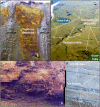The deep permafrost carbon pool of the Yedoma region in Siberia and Alaska
- PMID: 26074633
- PMCID: PMC4459201
- DOI: 10.1002/2013GL058088
The deep permafrost carbon pool of the Yedoma region in Siberia and Alaska
Abstract
[1] Estimates for circumpolar permafrost organic carbon (OC) storage suggest that this pool contains twice the amount of current atmospheric carbon. The Yedoma region sequestered substantial quantities of OC and is unique because its deep OC, which was incorporated into permafrost during ice age conditions. Rapid inclusion of labile organic matter into permafrost halted decomposition and resulted in a deep long-term sink. We show that the deep frozen OC in the Yedoma region consists of two distinct major subreservoirs: Yedoma deposits (late Pleistocene ice- and organic-rich silty sediments) and deposits formed in thaw-lake basins (generalized as thermokarst deposits). We quantified the OC pool based on field data and extrapolation using geospatial data sets to 83 + 61/-57 Gt for Yedoma deposits and to 128 + 99/-96 Gt for thermokarst deposits. The total Yedoma region 211 + 160/-153 Gt is a substantial amount of thaw-vulnerable OC that must be accounted for in global models.
Keywords: Arctic; Yedoma; carbon cycle; climate feedback; frozen organic matter; thermokarst.
Figures



References
-
- Battle M, Bender ML, Tans PP, White JWC, Ellis JT, Conway T. Francey RJ. Global carbon sinks and their variability inferred from atmospheric O2 and δ13C. Science. 2000;287(5462):2467–2470. doi:10.1126/science.287.5462.2467. - PubMed
-
- Burke EJ, Hartley IP. Jones CD. Uncertainties in the global temperature change caused by carbon release from permafrost thawing. The Cryosphere. 2012;6(5):1063–1076. doi:10.5194/tc-6-1063-2012.
-
- Ciais P. Large inert carbon pool in the terrestrial biosphere during the Last Glacial Maximum. Nat. Geosci. 2012;5(1):74–79. doi:10.1038/ngeo1324.
-
- DeConto RM, Galeotti S, Pagani M, Tracy D, Schaefer K, Zhang T, Pollard D. Beerling DJ. Past extreme warming events linked to massive carbon release from thawing permafrost. Nature. 2012;484(7392):87–91. doi:10.1038/nature10929. - PubMed
LinkOut - more resources
Full Text Sources
Other Literature Sources
Miscellaneous
